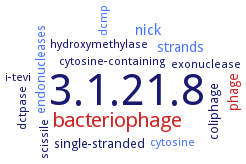3.1.21.8: T4 deoxyribonuclease II
This is an abbreviated version!
For detailed information about T4 deoxyribonuclease II, go to the full flat file.

Word Map on EC 3.1.21.8 
-
3.1.21.8
-
bacteriophage
-
nick
-
phage
-
strands
-
single-stranded
-
endonucleases
-
coliphage
-
i-tevi
-
cytosine-containing
-
cytosine
-
hydroxymethylase
-
dcmp
-
exonuclease
-
scissile
-
dctpase
- 3.1.21.8
- bacteriophage
- nick
- phage
- strands
-
single-stranded
- endonucleases
-
coliphage
- i-tevi
-
cytosine-containing
- cytosine
-
hydroxymethylase
- dcmp
-
exonuclease
-
scissile
- dctpase
Reaction
endonucleolytic nicking and cleavage of cytosine-containing double-stranded DNA =
Synonyms
denA, EndoII, endonuclease II, endonuclease IV, GIY-YIG enzyme, T4 endonuclease II
ECTree
Advanced search results
Substrates Products
Substrates Products on EC 3.1.21.8 - T4 deoxyribonuclease II
Please wait a moment until all data is loaded. This message will disappear when all data is loaded.
REACTION DIAGRAM
DNA where cytosine is partially or completely replaced by hydroxymethylcytosine + H2O
?
Tequatrovirus T4
DNA where cytosine is partially or completely replaced by hydroxymethylcytosine is degraded in vivo by T4 endonuclease II, EC 3.1.21.8, and endonuclease IV, EC 3.1.21.9
-
-
?
plasmid pBR322 + H2O
?
Tequatrovirus T4
-
double-stranded restriction cleavage at 12 sites in pBR322 commence before 10-min postinfection with T4 at 37°C and proceeds more slowly in the presence of competing phage DNA than in its absence, utilizing the same sites in both cases. In a 200-base pair segment of the plasmid, single-stranded nicks also are frequent. The plasmid sites are cleaved with a speed that varies with the site, yielding frequencies of cleavage at different sites varying between 10 and 90%, at 50-min postinfection. All sites contain good matches to a consensus, 5'-GRCCGCNTYGC-3', most frequently cleaved around the variable central base pair, generating fragments with blunt ends or 1-2-base 5' overhangs. A larger consensus sequence, 5'-CGRCCGCNTTGSYNGC-3', has been identified. DNA sequence elements 3' to the cut site appear important for rapid cleavage
-
?
?
Tequatrovirus T4
the phage T4 enzyme is involved in degradation of host DNA
-
-
?
DNA + H2O
?
Tequatrovirus T4
the phage T4 enzyme is involved in degradation of host DNA. The enzyme primarily catalyses nicking of the bottom strand of double stranded DNA between the first and second base pair to the right of a top-strand CCGC motif. Double-stranded breaks are produced 5fold to 10fold less frequently. It does not cleave the T4 native DNA, which contains 5-hydroxymethylcytosine instead of cytosine
-
-
?
?
-
Tequatrovirus T4
EndoII nicks both strands simultaneously at an in vivo-favoured site but not at an in vitro-favoured site. The right-side conserved sequence element at in vivo-favoured sites is important for simultaneous nicking of both strands, generating double-strand cleavage. EndoII nicks the lower strand about 1.5fold faster than the upper strand. In addition, the upper and lower strands are nicked independently of each other, seldom resulting in double-strand cleavage
-
-
?
additional information
?
-
Tequatrovirus T4
identification of seven major endonuclease II-dependent restriction sites in the T4 genome, in addition, abundant sites are cleaved in 55% of all molecules. Sites I, 11, and I11 share the sequence 5''CCGNNTTGGC-3' and are cleaved inabout 25% for I and III and 65% for II of all molecules, predominantly staggered around the first or second of the central unspecified base pairs to yield fragments with one 5' base. The less frequently cleaved sites I and I11 deviate from site I1 in predicted helical structure when viewed from the consensus strand, and in sequence when viewed from the opposite strand
-
-
?


 results (
results ( results (
results ( top
top






